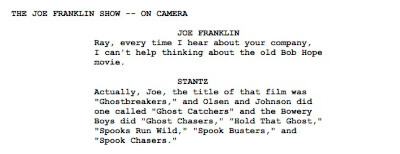Even The Original 'Ghostbusters' Was Fueled By Nostalgia

Who you gonna call? Some angsty Midwestern youths, apparently. Yes, this weekend, we're finally getting Ghostbusters: Afterlife, featuring Paul Rudd, the kid from Stranger Things, a character named "Podcast" for some reason, and America's newest sweetheart: Muncher. Of course, it's directed by Jason Reitman, son of Ghostbusters director Ivan Reitman, and best known to fans for his iconic performance as "Obnoxious Birthday Boy Every Kid in 1989 Hated with a Passion."
Afterlife is garnering the same middling reviews you'd expect for, well, a birthday party entertainment business that consists of sending two middle-aged men in jumpsuits to awkwardly gyrate in front of your children. The main complaint seems to be that the new movie is far too obsessed with nostalgia for its own good. This is a fair criticism, but it's worth pointing out that the original Ghostbusters was also an exercise in nostalgia, albeit one that wasn't as obvious to kids at the time.
The origin of Ghostbusters can be traced back to Dan Aykroyd's love of ghost-themed farces from the 1940s. According to Aykroyd, he thought at the time: "Wouldn't it be great to do an old-style ghost comedy like The Bowery Boys' Ghost Chasers or Bob Hope's Ghost Breakers, or the films of Abbott and Costello?" In addition to Ghost Chasers, the Bowery Boys also starred in a movie, perhaps not coincidentally called Spook Busters, that was literally about exterminators being hired to remove a ghost from a haunted mansion.
Early drafts of the Ghostbusters screenplay even included explicit references to these movies, underscoring that its core premise was an homage to those classic comedies.

Columbia Pictures
And the ghostbusting concept goes back even farther than that; there was also the 1937 Disney cartoon Lonesome Ghosts, in which Mickey, Goofy, and Donald Duck are professional "Ghost Exterminators." While never officially cited as an influence, it's hard to imagine that it wasn't. The bulk of the short in which the trio split up and explore an abandoned house isn't wholly dissimilar from the hotel scene in Ghostbusters, not to mention that both stories end up with the heroes slathered in white goo: floury molasses and marshmallow, respectively.

Disney

Columbia Pictures
And then there's this …

Disney
The story of how Aykroyd got the idea for Ghostbusters isn't so dissimilar from the plot of Afterlife either; he discovered some stuff his grandfather had stashed away in an old house. But it wasn't proton packs and ghost traps; it was "psychic journals and magazines." So Aykroyd decided to combine his childhood love of ghost comedies with the "real research" of his grandfather's journals.
There's nothing wrong with exploring nostalgia, but importantly, the original Ghostbusters used nostalgia to create something that recalled earlier works in some ways but was distinctly new in most others. They didn't, say, cast a Bob Hope lookalike or have the Ghostbusters stumble upon Abbott and Costello's old car.
Many of the best movies of all time have created something new out of nostalgic reverence for old material; George Lucas made Star Wars after he was denied the rights to Flash Gordon, for example. But these days, it seems as though big-budget filmmaking is so locked into a closed circuit of familiar intellectual properties that we rarely get blockbusters that are inspired by the past, only the ones that strive desperately to repeat it.
You (yes, you) should follow JM on Twitter!
Top Image: Sony





